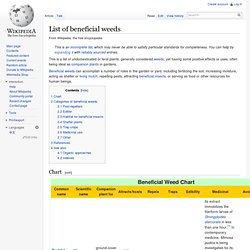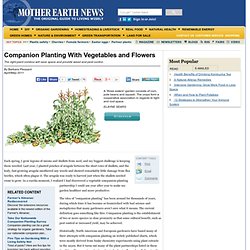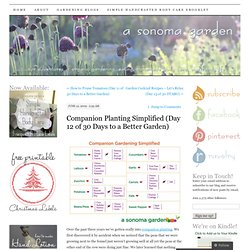

Companion Planting. Farmer's Pal Forums - Why do I plant marigolds in my vegetable garden? List of companion plants. Dill is one of the few plants to grow with Fennel This is a list of companion plants.

Many more are in the list of beneficial weeds. Companion plants assist in the growth of others by attracting beneficial insects, repelling pests, or providing nutrients, shade, or support. They can be part of a biological pest control program. Vegetables[edit] Fruit[edit] Herbs[edit] Flowers[edit] Other[edit] See also[edit] References[edit] External links[edit] Further reading[edit] Cunningham, Sally Jean. Plants That Stop — Even Eat — Mosquitoes. While I’m still gathering feedback on DEET -free repellents I thought you’d appreciate some information on plants that may help keep mosquitoes where they belong–far, far away from you. (Note: the leaves of the following must be crushed to release the aroma.
Otherwise mosquitoes can’t smell them): Photo: NellsWiki Horsemint has a scent similar to citronella and grows wild in most of the Eastern United States, from Mexico, Texas up to Minnesota to Vermont. It is partial to sandy soils and will grow in USDA Zones 5-10. Photo: D. List of beneficial weeds. This is a list of undomesticated or feral plants, generally considered weeds, yet having some positive effects or uses, often being ideal as companion plants in gardens.

Beneficial weeds can accomplish a number of roles in the garden or yard, including fertilizing the soil, increasing moisture, acting as shelter or living mulch, repelling pests, attracting beneficial insects, or serving as food or other resources for human beings. Companion planting - organic gardening. Baf9d8360a485f46636c4018ca59ed6b.jpg (2048×1992) Companion Planting. Companion Planting With Vegetables and Flowers - Organic Gardening. Each spring, I grow legions of onions and shallots from seed, and my biggest challenge is keeping them weeded.

Last year, I planted pinches of arugula between the short rows of shallots, and the leafy, fast-growing arugula smothered any weeds and showed remarkably little damage from flea beetles, which often plague it. The arugula was ready to harvest just when the shallots needed room to grow. In a eureka moment, I realized I had discovered a vegetable companion-planting partnership I could use year after year to make my garden healthier and more productive. The idea of “companion planting” has been around for thousands of years, during which time it has become so besmirched with bad science and metaphysics that many gardeners aren’t sure what it means. The current definition goes something like this: Companion planting is the establishment of two or more species in close proximity so that some cultural benefit, such as pest control or increased yield, may be achieved. Measuring Success. Companion Planting Advice.
As you are beginning to plan what will go where on your plot you may want to consider some of the benefits of companion planting.

Below is some advice from Scarcroft plotholder Linda James.... An eco-friendly way to eat more of your crops this year than the aphids! The carrot root fly hates the strong smells of sage, leeks and garlic so try sowing spring onions seeds with your carrots. I've planted rows of chives and spring onions beside my rows of carrots. Whitefly – my personal nemesis… windy conditions can keep whitefly at bay temporarily, as will a strong’ish hose down. Companion planting. I am keen to try out companion planting – the practice of planting beneficial plants with each other.

I started last year and had some success so this year I hope to try some different things. There are a few different aspects to companion planting – some plants improve the flavour and growth of others, some attract beneficial insects and some repel them. Some plants provide support and other provide shade. three sistersMany cultures have a similar planting method based on wisdom and observation. The Iroquois and other native Americans used to plant corn, beans and squash together. Insects borage flower Some plants produce volatile oils that deter certain pests. Vegetable companion gardening. Gardening - Gardening Guides - Techniques - Companion planting. Plant companions. Companion Planting - Secrets of Organic Gardening.
Companion-planting-chart4.gif (967×556) Companion Planting Chart, Map and Guide. Companion planting means putting plants together in the garden that like each other, or help each other out.

Companion planting can have a real impact on the health and yield of your plants. Organic gardeners strive to achieve a balance in their gardens so that they don't require chemicals for pest or disease control. Companion planting can play a significant role in assisting with pest control. Some combinations work because of scents they use to repel insects, others work because they attract good bugs. When planning your garden, take some time to think about the layout of your garden to incorporate some of the companion planting ideas.
Companion Planting With the Three Sisters Method. Companion Plants Chart - Earl May. My AccountGift Card BalanceStore DirectoryContact Us HomeShop OnlineAds/SpecialsTips & SolutionsServicesCareersAbout UsBulk Seed & Custom Packaging Companion Plants Chart Home » Tips & Solutions » Edible Gardening » Companion Plants Chart © 2014 Earl May Seed & Nursery.

All rights reserved. Companion Planting With the Three Sisters Method. Companion Planting - Vegetable Gardening Plant Companions and Combining. Home > Companion gardening Companion planting and combining means growing plants together that like or benefit each other.

Vegetable companion gardening can have a real impact on the health and yield of your plants. In nature everything interacts to create a whole life force. This is a basic understanding... that everything organic and living has a mutual influence on every other living thing. Every plant has an effect on every other plant and every creature has an effect on every other creature. Over time, gardeners have observed these interrelationships, and scientists have studied them. It’s well worth while reading a little bit about how and why companion planting is so important before we get into which specific plants go with what. . . .
Plants, unlike many people, are not timid. Companion Planting Simplified (Day 12 of 30 Days to a Better Garden) Over the past three years we’ve gotten really into companion planting.

We first discovered it by accident when we noticed that the peas that we were growing next to the fennel just weren’t growing well at all yet the peas at the other end of the row were doing just fine. We later learned that nothing grows well next to fennel. Soon after we bought the book Carrots Love Tomatoes from Amazon and now we carry that book outside each spring and fall when we are doing our plantings to find out who likes to grow next to whom.
The idea behind companion planting is that some plants benefit other plants in all sorts of different ways and yet others inhibit growth so you want to group together the plants that do get along and keep the bad companions away. Since then we’ve been pairing our tomatoes, basil and carrots together and had fantastic results with all: Carrots Love Tomatoes is an essential book if you are going to delve into the world of companion planting. Like this: Companionplanting.pdf (application/pdf Object) Companionplanting.pdf (application/pdf Object) List of companion plants. Companion Planting - Vegetable Gardening Plant Companions and Combining.